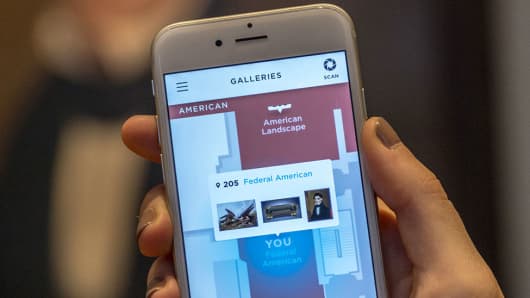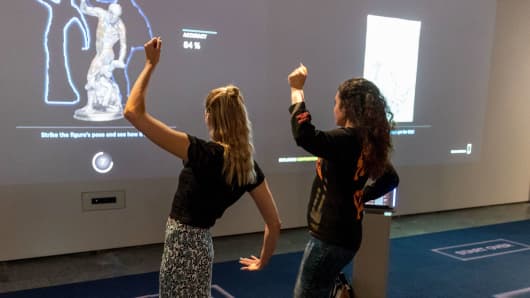
Museums are looking at the best attendance they’ve ever had, thanks to the way technology is revolutionizing the consumption of art.
According to the American Alliance of Museums, U.S. cultural institutions see more than 850 million visits per year — more than most sporting events — and represent about $21 billion in direct economic activity. Those impressively large numbers may be poised to grow, as museums boost their technological prowess amid a boom in mobile applications and offerings designed to enhance the experience of tech-savvy visitors.
To be sure, many art traditionalists are quick to criticize the integration of virtual reality and Van Gogh. However, museums are making a surprising discovery: technology isn’t hindering the appreciation of physical art.
In fact, museum attendance has skyrocketed more than ever since computers and iPads entered the art realm, some art experts say. It’s allowing visitors to experience art in a new way, while bringing exhibits to others that may never even set foot in the institution at all.
So why wouldn’t visitors be tempted to abandon museums altogether in favor of scrolling Instagram? It boils down to physical experiences that make art more memorable —just like with any relationship, according to the founder and CEO of Artsy, the world’s largest online collection of art.
“Ultimately, the physical experience of art is more just like online dating,” Carter Cleveland told CNBC recently. “We want to meet someone physically in the end, but it’s spurred with online platforms.”
“The best use of digital is to not make you aware of the technology, but to make you aware of the art.”
For certain segments of the population, museums are consistently highly valued, said Susie Wilkening, a spokesperson for museums at Wilkening Consulting. But that’s only a sliver of the population. For a bigger chunk, museums are a means to an end; they’re used as deliberate family time or to fulfill a trend.
That’s where tech comes in, Wilkening said. It caters to the visitors on the fence, making museums seem like an easier choice.
“The best use of digital is to not make you aware of the technology, but to make you aware of the art,” said Jane Alexander, chief information officer at the Cleveland Museum of Art.
“It’s about putting art on the forefront. […] It’s about better practices and thinking about how can this be a toolset to get people into the collection,” she added. “How can people use our collection to bring art into their daily lives?”
The museum is the home of the ArtLens Gallery, featuring high-tech gear like eye-tracking, motion detection and facial recognition that “surpasses barriers” in the service of drawing in art lovers.
Using an application, visitors can touch art, favorite the exhibits they like most and “create your own tour,” Alexander told CNBC. “Our goal is to get people into the galleries, and give them the tools.”
Spaces like the Gesture and Expression exhibit allow visitors to strike a pose like the figures of a painting, while a gaze tracker reveals where a visitor focuses when looking at a work of art. The six exhibits feature 14 “games” in total, allowing everything from altering the expression of figures in paintings, to decoding symbols.
“This is not about digital for digital’s sake,” Alexander said. “This is about seeing an object that may have only been 4 feet high, and seeing it enlarged and how it was made. It makes [people] want to see the object, and they’re left in awe. ‘I cannot believe this object,’ they say, ‘it’s so beautiful.'”
‘Stronger than ever’
While the Cleveland Museum exhibit is fairly new, even long-standing museum giants are integrating technology, and getting a positive reaction. At the Metropolitan Museum of Art in New York City, attendance is “stronger than ever,” with “more than 7 million visitors in 2016,” said Ken Weine, the museum’s chief communications officer.
The Met recently digitized more than 380,000 images from its collection, making art available to download on any computer, anywhere. Instead of simply promoting computer-screen consumption of art, the shift to digital sparked more museum interest than ever, Weine said. It opened up a new realm, merging the tech savvy with the art fanatics.
“People enjoy being in a common space with their own friends and family, and seeing others taking in all parts of art and culture,” Weine said. “But they also value technology. People enjoy the image of Washington crossing the Delaware as they cross the street. It’s our job’s responsibility to build the best experience for both of these groups.”
For those who don’t have the resources to afford a visit to the museum, tech goes beyond adding cool gadgets and gears. Tech can play the role to integrate museums in the broader community. It introduces art — via iPads in public parks or videos in cab rides, for example — to people who wouldn’t otherwise have the time or resources to visit a museum.
“How do we take museums to … low-income people?” Wilkening asked. “Why don’t we have museums in laundromats, grocery stores? Bring a project to a food bank? It’s low stress, easy, and welcomed.”
[“Source-cnbc”]


